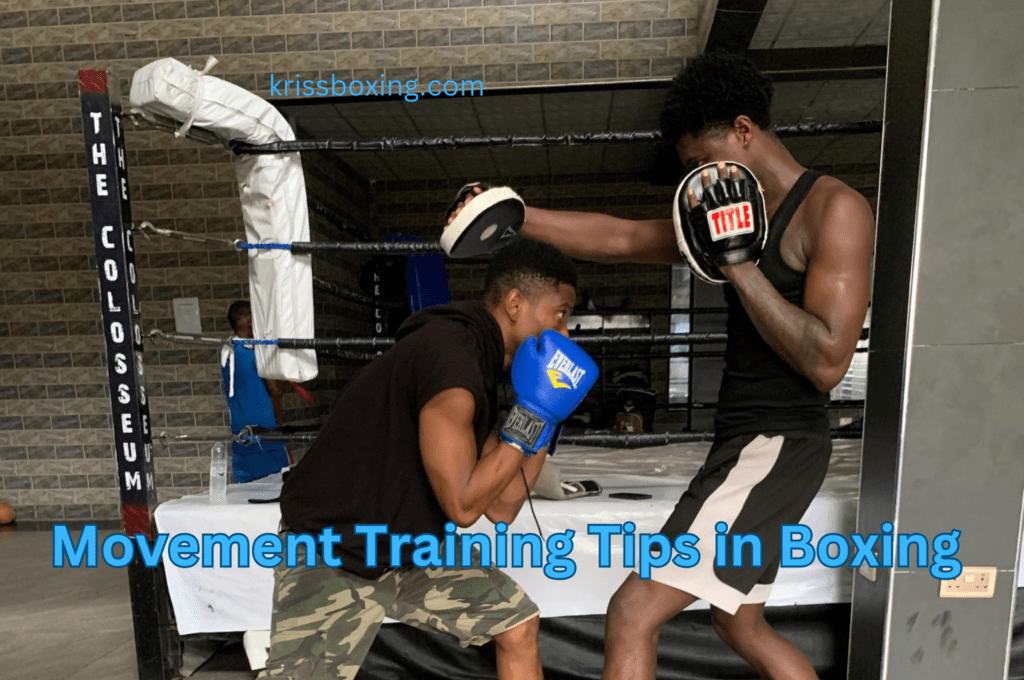In boxing, to disarm your opponent, one has to master the various ways of moving or changing positions in the ring.
This article explores primary movement training strategies that could improve your boxing ability and enhance your tactics in the ring.
Now let’s explore the importance of movement in boxing.
Understanding the Importance of Movement
Defensive Benefits
Such movements are vital when confronting punches to minimize potential injuries.
Sliding, ducking, dodging, and other stances enable one to escape the blows of an opponent while keeping an eye on counterattacks.
Offensive Advantages
It allows you to establish your positioning for an attack and create a gap or an opportunity.
Constant motion also keeps the opponent off balance as they will not be able to anticipate your next move.
This makes your attacks more potent and makes it difficult for the opponent to counter your moves.
Key Movement Training Techniques
Footwork Drills The Foundation of Movement
Staple movement in boxing must be emphasized with an emphasis on foot movement being crucial.
It refers to the ability to maneuver properly to avoid getting off balance, positioning yourself at the right angle with your opponent, and setting the proper range that you want.
Ladder Drills
Ladder drills exercise lower body flexibility skills and general fitness with a view to achieving sharp and accurate footwork.
With the help of such ladder patterns, boxers can become more mobile in varied directions at a fast pace.
Cone Drills
Cone drills include running through a set of cones both placed at equal distances apart and in different formations.
It enables you to practice how to change direction frequently and how to maintain balance while in motion—all of which come in handy while attacking or defending yourself in boxing.
Shadowboxing with Movement Focus
Visualizing Opponents
Shadowboxing shouldn’t be a simple exercise of throwing punches but should rather try to simulate the fight scenario.
Visualizing your opponent’s movements and practicing evasive maneuvers helps your brain begin to think in those directions, preparing it for various situations when fighting.
Incorporate Footwork
As you shadowbox, you’re looking to string together some footwork with your punches: moving in and out, side to side, while practicing pivoting on your feet to create angles.
This, again, builds a lot of muscle memory and makes you a ton better of a mover around the ring.
Advanced Movement Strategies
Pivoting and Angling
The techniques of pivoting and angling are advanced, which keeps you in a better position to be able to attack without getting hit.
It enables you to change positions right after the punch by pivoting on your lead foot, creating other angles from where one can strike.
Practice Pivoting
Add some pivot drills to your workouts. Pivot halfway through combinations and then use it to reposition yourself to set up counterattacks.
This is what tends to confuse the opponent, but it gives you other angles from which you can throw your punches.
Cutting the Ring
Cutting the ring means you strategically move, therefore limiting your opponent’s mobility and controlling the pace of the fight.
You will ensure that by cutting off the ring, always an opponent is backed into a corner or against the ropes; at this position, it’s hard to run or make a counterattack.
Movement Patterns
Practice specific movement patterns to effectively shut off the ring.
This would include stepping to the side and moving forward, places that would reduce the opponent’s space.
Combine these movements with feints designed to keep your opponent guessing, off guard, and off-balance.
Frequently Asked Questions
Why is movement important in boxing?
Movement in boxing is important for improving defense and offense. It enables a boxer to move out of the way from punches, create favorable angles from where one can launch their attacks, maintain balance, and tempo of the fight, and sustain lesser fatigue. All of this comes with effective movement that can prove one strategic edge in the ring.
What are some of the basic drills in boxing to develop better footwork?
Key exercises to attain footwork would include ladder drills and cone drills. Agility and coordination can be improved with ladder drills by working with the tool of the ladder for running several patterns. Cone drills give one a feel about how to change directions, and quickly shift balance while maintaining balance on the move-around cones at varied intervals.
how does shadowboxing contribute to movement training?
Shadowboxing is useful in movement training because it offers the boxer an opportunity to give areal opponents and even create a sense of fight in this case. It makes it easier to come up with ways to avoid blows, coordinate the steps with punches, and create muscle memory when it comes to movement in the boxing ring. This increases the general flexibility and adaptability to the execution of operations.
Conclusion
Of all the facets involved in boxing, movement is key to swaying any match.
Mastery of the footwork drills, shadowboxing with movement, and higher-order techniques such as pivoting and cutting the ring will help you outsmart your opponent, hence gaining an upper hand.
The more frequently you apply these techniques and stay true to these methods, the better a boxer you will emerge. You’ll be more agile, elusive, and effective in the ring.





So lovely.